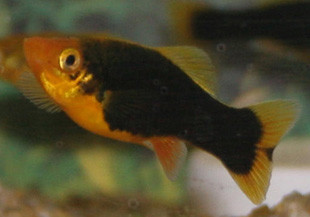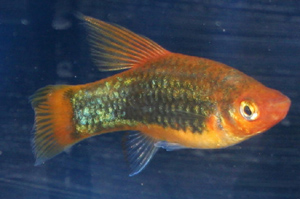Platy – Xiphophorus Maculatus
The Platy comes from Central America from Mexico to Guatemala. It is a livebearer. The male has a copulatory organ that it uses to impregnate the female. It is interesting to watch the female grow fatter and then one day – platy fry can be found swimming in the tank. Unless you want to provide fun and food for other fish in the tank (including platys) the fry should be removed. Platys have been bred to include many different color patterns and looks. Currently available varieties Include: Red-Wag-tail Platy, Tuxedo Platy and many variations on the high fin theme. fin theme.
Maximum Size: The maximum length is 2.7 inches. The females are larger than the males.
Minimum Tank Size: 10 gallons or larger tank is appropriate.
Care Level: The Platy is a hardy fish. On a scale of 1 –10, (10 being easy) it would rate an “8”.
Tank Conditions: Temperature 70 - 78°F; pH: 5.8 – 8.5; pH: medium to hard. dH range: 10-28
Description: The common Platy has a classic fish body. As the pictures show, there are many color variations and body shapes
Temperament: Platys are small, lively fish. They are compatible with other active fish of similar size. Like most Platys it does best in groups.
 Diet: Omnivore Live mosquito larvae, Tubifex worms, crustaceans, Drosophila; high quality flake foods and algae Diet: Omnivore Live mosquito larvae, Tubifex worms, crustaceans, Drosophila; high quality flake foods and algae
Habitat: Provide with live plants, floating plants, rocks, and open swimming areas, avoid too much driftwood as a rule the livebearers do not like acidic water. There should be gentle surface water movement. It typically inhabits the middle strata of the tank.
Lighting: No special lighting requirements are necessary.
Compatibility: Platy in general can be kept with most other species that can handle the ph and temperature requirements. It is an active fish. It is best to keep in small groups.
Remember that as you look to add more fish to a tank, you will need to increase the tank size. As with all aquarium setups, whether it is fresh or salt, consideration needs to be given to the maintenance of water quality. Too many fish can result in poor water quality that can stress and even kill our fish.
|


 fin theme.
fin theme.  Diet: Omnivore Live mosquito larvae, Tubifex worms, crustaceans, Drosophila; high quality flake foods and algae
Diet: Omnivore Live mosquito larvae, Tubifex worms, crustaceans, Drosophila; high quality flake foods and algae